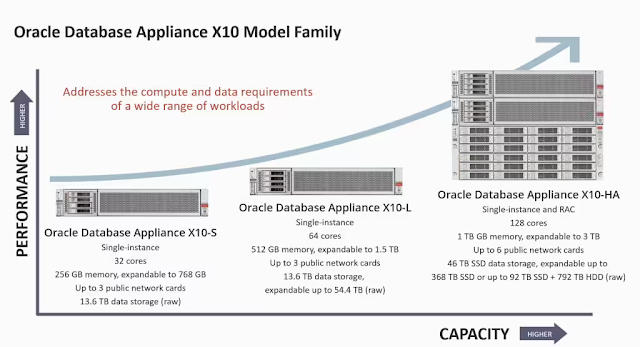We are pleased to announce the next generation Oracle Database Appliance X10. Oracle Database Appliance has been adopted around the world and in all industries by a wide range of customers, especially small and medium sized organizations and business units, as well as those with distributed locations. It allows them to run Oracle Database and applications on economical, and easy to deploy and manage systems.
By combining easy-to-use Appliance Manager software with the latest generation of processor, memory, and storage technologies, and offering them starting at the same low entry price as previous generation systems, Oracle Database Appliance X10 delivers:
◉ A simple, optimized, and affordable database system with built-in automation
◉ Integrated full-stack software updates that are easy to deploy
◉ Pay as you grow, Capacity-On-Demand licensing for Oracle Database
◉ Cost-effective consolidation for databases and applications
◉ Integration with Oracle Cloud Infrastructure to simplify your cloud journey
Oracle Database Appliance X10 Features and Benefits
Oracle Database Appliance X10 features fourth-generation 32-core AMD EPYC™ processors with twice the cores, up to 50% more DDR5 memory, and 50% more memory channels than the previous generation system. With these enhanced capabilities you can achieve up to 50%higher OLTP database performance per core and a 150% increase in total performance compared to the previous generation platform. By providing more performance for the same entry pricing, customers achieve substantially improved price/performance. In addition, Oracle Database Appliance X10-HA high-capacity model can now hold 22% more data than the previous generation.
The increase in CPU cores, memory, and disk storage capacity enables Oracle Database Appliance to support larger database shapes, higher database consolidation, and enhanced solution-in-a-box capabilities that run both application and database VMs.
Recent Oracle Database Appliance Software Enhancements
Oracle continually updates Oracle Database Appliance software to make existing and new systems easier to deploy, manage, and use. Some of the current and recent software enhancements include:
- Oracle Database Appliance X10 ships with Oracle Database Appliance SW 19.20.0.1 and Oracle Linux 8 delivering improved performance, security, and management infrastructure.
- Upgrading Oracle Database Appliance using Data Preserving Reprovisioning (DPR) Upgrade your appliance from earlier Oracle Database Appliance software releases to the latest release in one step using DPR. With this upgrade utility, you reimage and reprovision your Oracle Database Appliance system to the latest release while preserving the database files. This process avoids your having to redeploy your databases.
- Enterprise Edition High Availability. This Oracle Database Appliance exclusive capability lets you automatically protect single-instance Oracle databases. When creating databases on Oracle Database Appliance, you can enable or disable high-availability for single-instance Enterprise Edition Oracle Database.
- Migrating and Registering TDE-Enabled Databases. You can easily migrate Oracle databases with Transparent Data Encryption (TDE) that are created outside the Oracle Database Appliance framework into your Oracle Database Appliance deployment using the "odacli register-database" command. After successful registration of the TDE-enabled database, the lifecycle management of databases and TDE wallets are supported, similar to any TDE database created using Oracle Database Appliance.
- Registering Oracle Data Guard on Oracle Database Appliance. You can migrate existing Oracle Data Guard configuration and register with Oracle Database Appliance using integrated Oracle Data Guard configuration capabilities.
- Oracle Database Appliance multi-user access. Multi-user access enhances the security of your appliance and provides an efficient mechanism for role separation. With multi-user access, you can provide separate access to database administrators to manage databases and create multiple users with different roles that restrict them from accessing resources created by other users and restrict the operations they can perform.
Source: oracle.com





0 comments:
Post a Comment